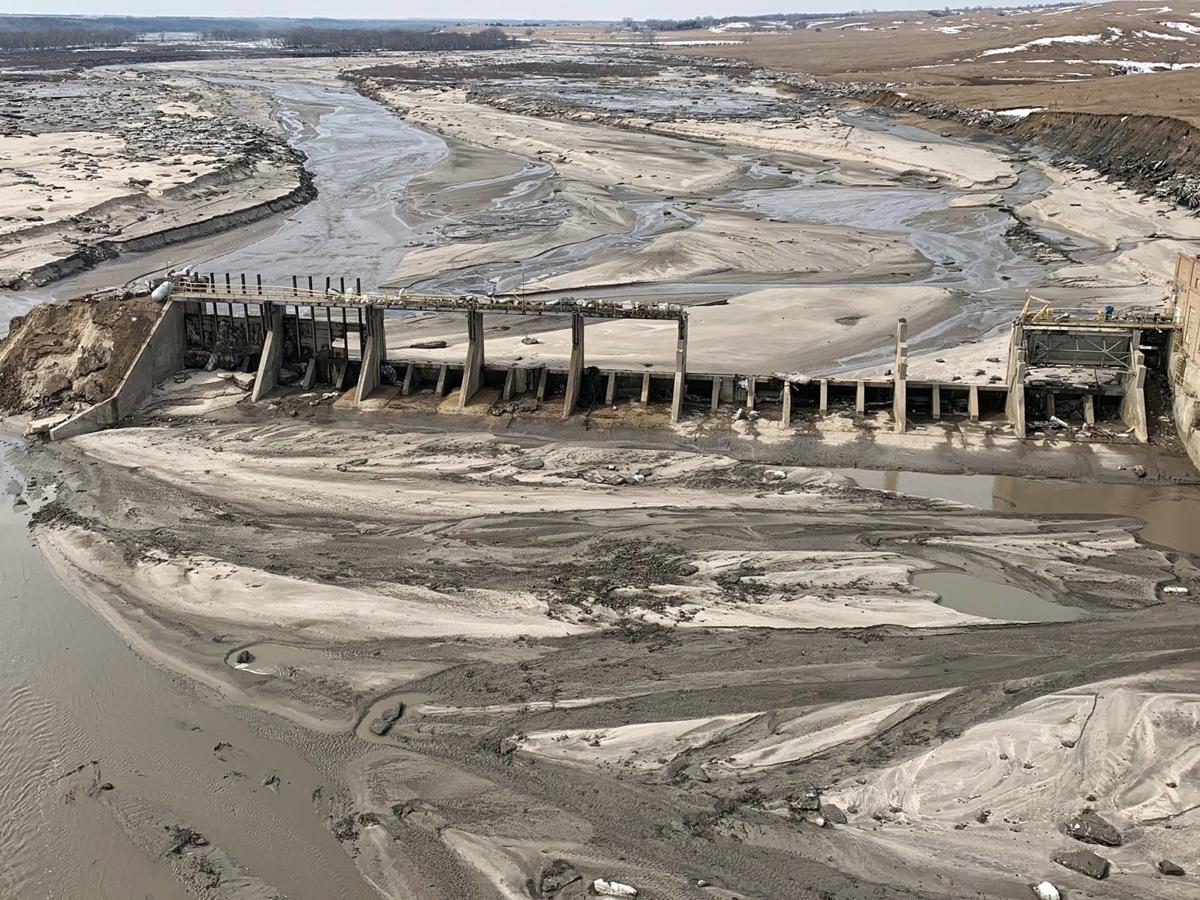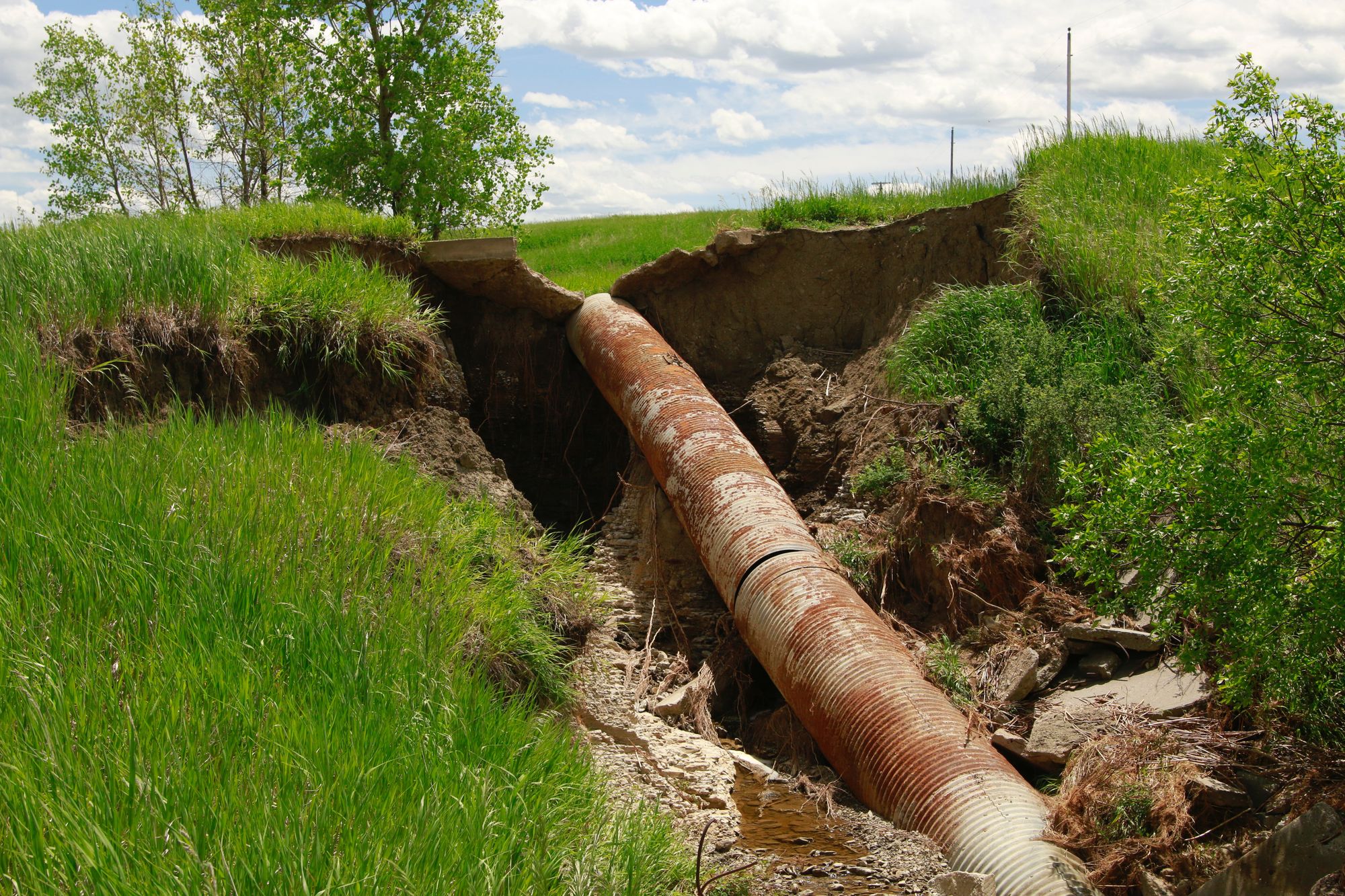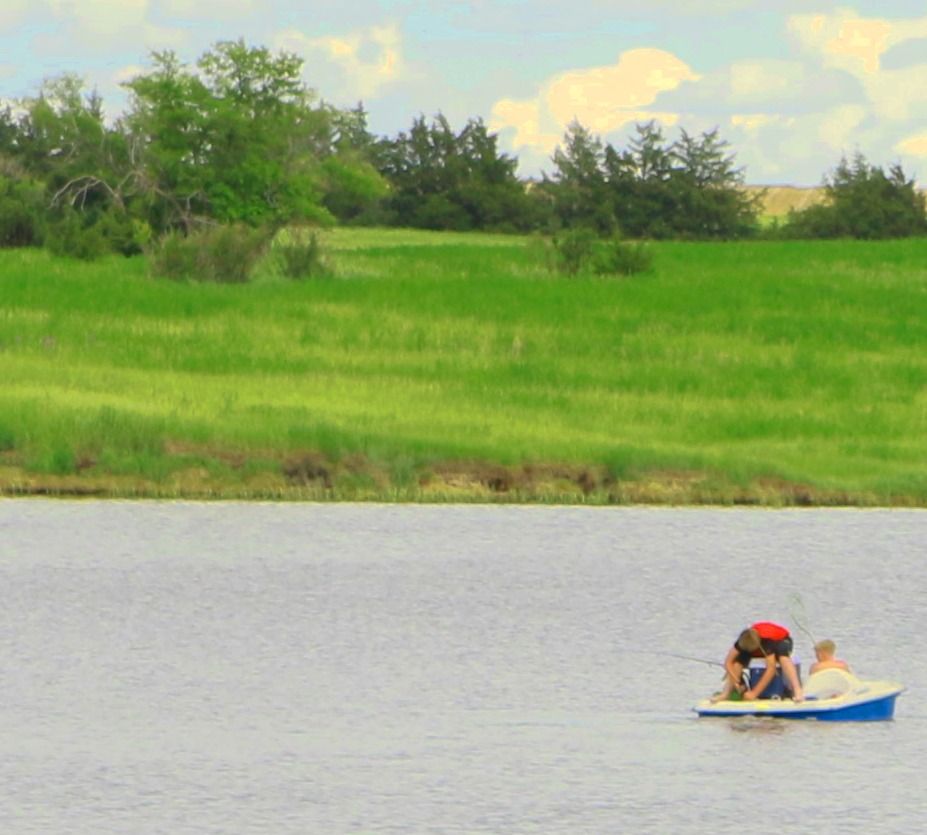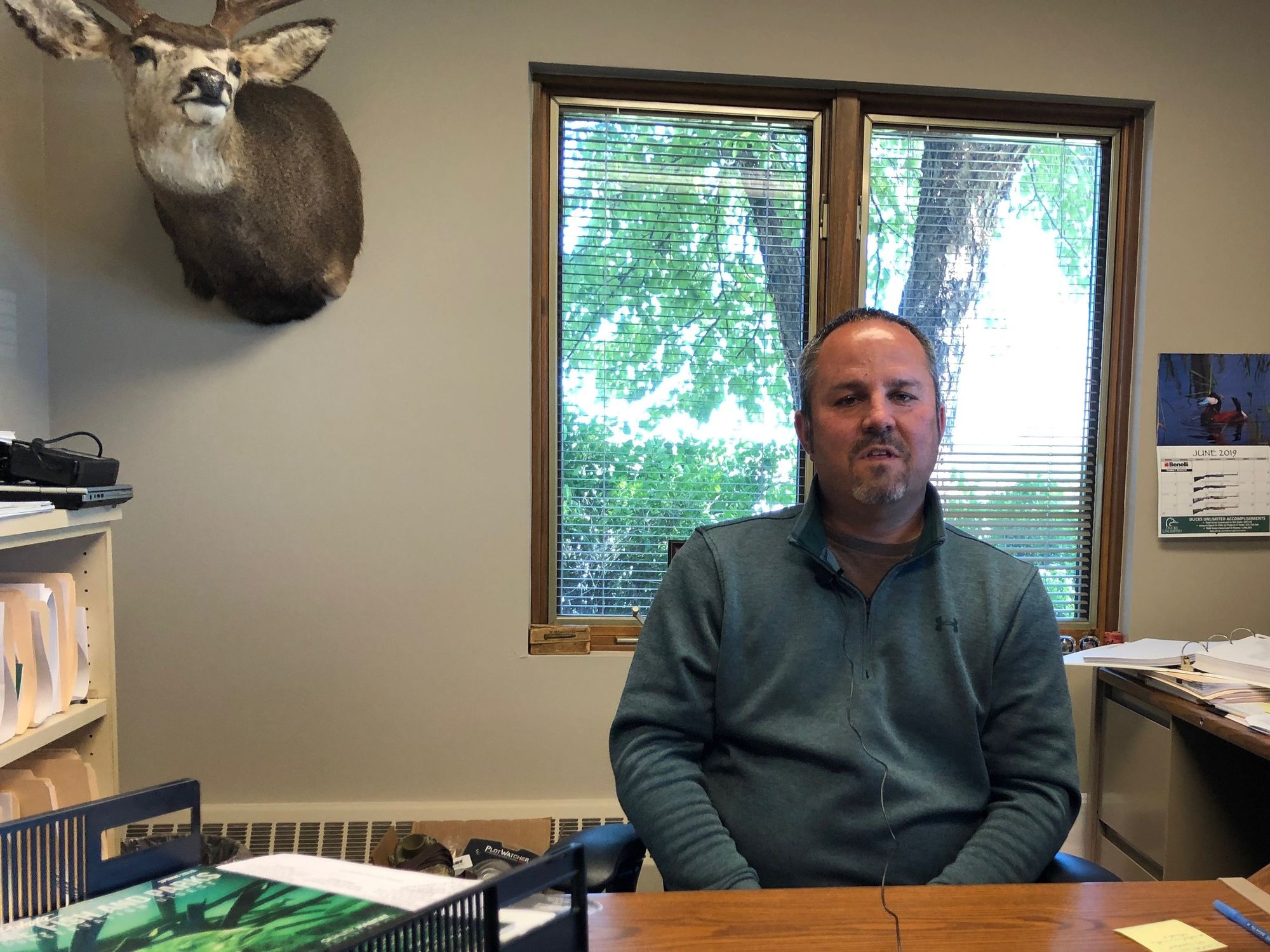The last 12 months have been the wettest in South Dakota in more than a century and as a result, dams across the state have suffered significant damage, creating the potential for flooding, loss of life, destruction of property and the need for expensive repairs.
Across South Dakota and the Great Plains, extensive snow melt and heavy rains have eroded spillways, plugged outflows, caused leaks and led a few dams to fail completely. The wet weather has exposed weaknesses in the state’s system of dams that in many cases are aged and worn.
A leak in the Quinn Dam near Phillip in central South Dakota in March forced the closure of U.S. Highway 14, one of the state’s few east-west highways, while engineers determined the threat level. Murdo Dam, a 1930s-era Works Projects Administration dam just outside the town of Murdo in Jones County, saw its spillway severely erode this year.
State officials eventually determined that Quinn Dam wasn’t in imminent danger of failure and re-opened the highway. Officials still are trying to determine the extent of damage to Murdo Dam and what do about it.
“It seems like every year there’s one or two that go out,” said Ron Duvall, water rights permitting administrator for the Department of Environment and Natural Resources.
The issue of aging dams and reservoirs isn’t unique to South Dakota. In March, the 90-year-old Spencer Dam on the Niobrara River in northeastern Nebraska failed and washed out homes, farms, businesses and infrastructure downriver; one man remains missing.

Estimates by the Association of State Dam Safety officials peg the cost of needed maintenance for the country’s more than 87,000 non-federal dams at roughly $66 billion. Around 15,500 of those dams, if they failed, could cause serious damage to property or could kill people. Just fixing those state-managed “high-hazard” dams would come at a cost of around $20 billion.
South Dakota’s share of those costs is much smaller, though state officials do not have a firm repair estimate. Still, there are more than 2,500 dams in the state that qualify for listing on the National Inventory of Dams, meaning they hold more than 50 acre feet of water — about 16.25 million gallons — or have the potential to kill people or cause significant property damage if breached.
The maintenance problem has been slowly building over decades and it comes with another, potentially more expensive wrinkle. The lakes behind the dams are deteriorating too, placing the state’s multi-million dollar fishing and boating industries in peril.
South Dakota reservoirs support much of the state’s $270 million annual recreational fishing industry and its roughly $85 million annual boating industry, but dams and the reservoirs behind them are starting to show their advanced age.
Most of the dams in South Dakota were built more than 60 years ago as part of a decades-long boom in dam construction that swept the country beginning around the year 1900. Dams were built to control water for irrigation, to store drinking water and create opportunities for recreation. The dam building boom also set the stage for recreational fishing and boating to become multi-million dollar industries.
A combination of decayed flooded vegetation, sedimentation and too many nutrients flowing in from upstream changes the way lakes function and often decreases both the quality of the water and its fish carrying capacity. The process takes decades but if left unaddressed, a lake can be rendered nearly lifeless and full of toxic bacteria.

Most dams in SD are several decades old
Nearly all of South Dakota’s reservoirs were built during the first half of the 20th century. A whole bunch of them were built during the Great Depression when the Civilian Conservation Corps and the Works Progress Administration were created. Age and an increase in severe weather events have taken their toll on those depression-era dams.
The reservoir known as Lake Hiddenwood northeast of Selby was created by an earthen dam built in 1927. The dam washed out after heavy rains in the spring of 2018, and destroyed a bridge. The reservoir, owned by the Game Fish & Parks Department, is home to a state recreation area; the park there remains closed.
Hidden Timber Dam, a WPA project east of Mission, was overwhelmed by snowmelt from back-to-back blizzards and heavy rains and breached this spring. What’s left of the dam still is owned by the South Dakota Office of School and Public Lands, which now is responsible for many dams built by public programs in the first half of the 20th century.
“It had a significant amount of silt in it,” School and Public Lands Commissioner Ryan Brunner said of Hidden Timber Dam.
GFP now controls about half the CCC and WPA dams. Some of the remaining dams were built on federal land and are now managed by federal agencies, but many more were given to the state for purposes other than recreation and now are managed by the office of School and Public Lands.
Most of South Dakota’s roughly 2,550 nationally inventoried dams, however, are privately owned. They serve a variety of functions, from holding livestock water to forming family fishing ponds. But nearly all such dams are too small or don’t present enough danger to lives or property to get regular inspections from DENR, the agency responsible for state-regulated dams.
Dams that could kill people if they fail are designated as “high-hazard.” The state has 91 high-hazard dams of which 44 are regulated by DENR. The remaining 47 high-hazard dams are owned, operated and maintained by various federal agencies.
For the most part, privately owned dams considered high-hazard are really only a danger to the person who owns them, said Whitney Kilts, an engineer who heads up the DENR dam safety inspection program. Privately owned dams, however, tend to have the most problems.
The few high-hazard dams rated as being in poor shape are privately owned, Kilts said. There’s not much the department can do to fix those impaired dams. Kilts’ job is to inspect and let the owners know there’s a problem. Dam owners are responsible for making repairs at their own expense.
Billions needed to fix nation’s dams
Each year, the Association of State Dam Safety Officials estimates the potential costs of making repairs to all of the nationally inventoried dams in the United States. This chart shows the ownership category and hazard level, as well as estimated total dam repair costs as of 2018.
- Non-Federal total: 87,640 dams; $65.9 billion to repair
- Non-Federal High Hazard: 14,343 dams; $20.4 billion to repair
- Federal total: 3,828 dams; $4.8 billion to repair
- Federal High Hazard: 1,286 dams; $3.3 billion to repair
Source: Association of State Dam Safety Officials
Jeane Goodman, chief engineer of DENR’s water rights program, where the state’s dam safety program is housed, can issue a formal order to the owner to force them to make repairs, but that doesn’t happen often. Goodman said she can’t remember ever issuing such an order.
Because repairs can be costly and there are few, if any, dam repair assistance programs, some dam owners choose not to make the repairs at all. A private owner of a poorly rated high-hazard dam can sign an affidavit absolving the state of liability if the dam fails, Duvall said.
State-owned, high-hazard dams, meanwhile, are in pretty good shape, Wiltz said. A good example is Bednar Dam in Ziebach County about a mile northwest of Dupree, she said. With a storage capacity of 176 acre-feet, it is managed by the Office of School and Public Lands.
If Bednar Dam fails, the town of Dupree likely would be in the path of the resulting flood. During a regular inspection in 2015, Wilts found a hole on Bednar Dam. The report was delivered to the Office of School and Public Lands and when Kilts returned in 2018, the hole had been fixed.
The Office of School and Public Lands spent about $28,000 repairing the dam in 2017, Brunner said. In all, the office spent a combined total of $84,190 on dam maintenance between 2017 and 2018 to repair three dams, he said.
In 2019, Brunner said, the Office of School and Public Lands is planning to spend more than $500,000 replacing the spillway on Elm Lake north of Aberdeen, adding to the roughly $1.25 million the office has spent on dam repair over the past six years. All the money has come from special appropriations made by the state Legislature.
“Anytime we’ve presented a high-hazard dam that needs repair, the governor and legislature have provided funding,” Brunner said.
Oftentimes, local groups or nearby cities will pitch in, he said. The Elm Lake dam project, for example, is projected to cost more than $1.5 million. The city of Aberdeen and a few other partners will contribute about $1 million.
A similar but smaller project will repair the Leola Dam on the southern edge of the town of Leola in McPherson County. Leola Dam is considered low hazard because it is downstream from the town. A county highway runs across the dam so the Office of School and Public Lands is working with McPherson County to repair and improve the dam both for safety and to improve the lake for fishing and swimming, Brunner said.
“It’s a neat community resource,” he said.
Jason Jungwirth is a GFP fisheries biologist who became the department’s aquatic habitat and access coordinator last year. Part of Jungwirth’s job is to help figure out how that department will prioritize dam maintenance efforts. An ongoing effort is underway to devise an aquatic habitat management plan that will incorporate dam maintenance. Exactly what the dam maintenance plan will look like going forward hasn’t been figured out yet, Jungwirth said. But, for now, if one of GFP’s high-hazard dams needs urgent repairs, the department works with its engineers to get the work done.
Jungwirth said a greater concern for GFP right now revolves around the status of reservoirs behind many of the dams in the state.

Reservoirs below aged dams face challenges
Lakes all over the state, but particularly in the southeast, have seen their productivity and water quality slowly decline over the past few decades, Jungwirth said.
When built, the reservoirs were great places to fish because they were full of places for fish to hide, breed and hunt. Reservoirs produced a lot of fish that people could catch. But as they’ve gotten older, many of the trees, bushes and rock piles have rotted away or been covered in silt.
As productivity and water quality decline, the lakes see less use. That can be a problem for nearby communities which get an injection of cash from the state’s anglers and boaters. Of the roughly $271 million anglers spend in South Dakota, only about $47 million was spent on the massive federally owned reservoirs along the Missouri River. Most of the spending is done around smaller reservoirs, many of which are owned by the state.
Jungwirth said GFP has used fish stocking to help counteract the effects of age on state reservoirs. Stocking can be effective over the short term, even in unhealthy lakes, but it masks the underlying larger problem and has kept the problem of aquatic habitat loss out of the public eye.
“(Habitat) hasn’t been a focus for a lot of years,” Jungwirth said.
Jungwirth’s position was created in 2018 specifically to devise a long-term solution to the fish habitat problem. The process will be expensive and take decades to complete, but by the end of this summer, Jungwirth said, the department should have a new aquatic habitat and access plan to guide future state efforts to improve fishing and water quality.
“Water is essential for all life,” Jungwirth said. “The better, cleaner the water is, the more life it’ll support.”

Lake Mitchell, on the northern edge of Mitchell, is a good example of what can happen when a reservoir gets old.
The 600-acre lake sits on the Firesteel Creek watershed, a roughly 360,000-acre area full of farms, ranches and feedlots. The Lake Mitchell dam was built in 1928, mostly to create a massive storage tank for the city of Mitchell’s drinking water. It is one several dams in South Dakota that is owned and maintained by a city.
Like many of South Dakota’s reservoirs, Lake Mitchell has long collected the excess fertilizer, livestock wastes and loose topsoil that runs off of fields and pastures within its watershed. Since the 1970s, Lake Mitchell has sometimes closed to swimming and other forms of recreation that involve immersion, said Mitchell Public Works Director Kyle Croce. The closures have been due to toxic blue-green algae blooms and high concentrations of bacteria from runoff.
Runoff is a problem for South Dakota reservoirs because once moving water hits the lake, all of the fertilizer, feces and dirt suspended in it settle to the bottom. The dirt, over time, builds up and makes the lake shallower, which means it warms up faster. The dirt also covers up the rock piles, flooded trees and other cover in which fish species such as bass, bluegill, perch and walleye use to breed and feed.
The presence of fertilizer, and to a lesser extent animal feces, when combined with warmer, shallower water creates an ideal place for toxic blue-green algae to thrive. Blue-green algae isn’t actually algae; it is a cyanobacteria, one of the Earth’s oldest forms of life.
Cyanobacteria are one-celled organisms that use photosynthesis, much like plants, to make their own food. As such, they rely on many of the same sorts of nutrients as plants like corn or soybeans. Cyanobacteria also tend to grow in colonies. When the water is shallow, warm and chock full of phosphorus and nitrogen, cyanobacteria colonies become massive, floating, slimy, sometimes toxic blooms. The blooms can get so big that they block sunlight from reaching aquatic plants which can lead to a reduced oxygen level in the water. Like all living things, fish need oxygen to survive.
There are several types of cyanobacteria that produce toxic chemicals through the course of their lives. When those bacteria die and their cell walls break down, those toxins — known as cyanotoxins — are released into the water. People and pets who come into contact with cyanotoxins can develop rashes, diarrhea, cramps and difficulty breathing.
The presence of cyanotoxins and fecal coliform bacteria, such as E. Coli, are two of the biggest causes for lake closures or listing by the state as unsafe for swimming, water skiing or any other type of recreation that involves water contact.
Lake Mitchell has been on the DENR list of impaired water bodies for several years, Croce said. It is just one of a growing list of South Dakota reservoirs that have problems with siltation and too many nutrients. Adding to the list of issues is an ever-shrinking amount of aquatic habitat.
South Dakota does have a few successful models to borrow from. The state of Nebraska, for example, has been working on the habitat and water quality of its lakes, almost all of which are reservoirs, since 1997.
Nebraska created a $5 aquatic habitat stamp that anyone who wants to fish in the state has to buy. The stamp funds Nebraska’s aquatic habitat program, which has placed artificial habitat structures and built sediment catch ponds upstream from bigger lakes. In some cases reservoirs have been completely drained so nutrient-laden sediments can be bulldozed out, lake beds can be re-sculpted and more permanent habitat structures can be placed.
A notable example of draining and dredging is Conestoga Reservoir, located a few miles southwest of Lincoln, Neb. The lake was emptied, dredged and the bed was re-sculpted. Sediment catch ponds were created at the reservoir inlet. The project was completed in 2018.
Jungwirth said he and a few other GFP staffers have made trips to Nebraska to view that state’s progress. One lesson learned so far, he said, is that making improvements to any lake requires buy-in from nearby communities. Big projects are too complex and too expensive for one agency, city or non-profit to tackle on its own, Jungwirth said.
Dredging the nutrient-laden silt out of Lake Mitchell would cost from $6 million to $10 million, Croce said. “For a small municipality in South Dakota, that is overwhelming,” He said.
Still, removing at least some of the phosphorus and excess dirt is necessary to get the water quality back to par, Croce said. A group called “Friends of Firesteel” has formed with a goal to raise money to rehabilitate Lake Mitchell, he said.
Earlier in 2019, the city commission approved an agreement to seek help in writing grants to help pay for a planned wetland restoration project on a $4.1 million piece of property the city bought along Firesteel Creek about a mile and a half west of Lake Mitchell. The goal is to create a filter to catch sediment before it hits the lake.
Jungwirth said many South Dakota reservoirs, if cleaned up, might have the potential to boost local economies. After the statewide aquatic habitat plan is finalized, Jungwirth said his goal is to identify a lake near a city that needs restoration and do what he called a demonstration project.
The idea would be to completely restore the chosen lake, a project that could take up to 10 years, and show other communities how they can benefit from a cleaner, more useful reservoir.
While Mitchell no longer uses Lake Mitchell for drinking water, cleaning the lake up could have big economic benefits for Mitchell, Croce said. The city sits on Interstate 90 and about 70 percent of the lake’s shoreline is publicly owned. As a prime spot for recreation-based tourism, any improvements would enhance the quality of life for Mitchell residents and its economy, Croce said.
“I think there’s a lot of potential in this area,” he said.



